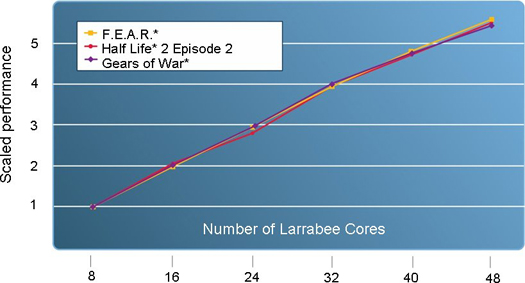Intel's Larrabee Architecture Disclosure: A Calculated First Move
by Anand Lal Shimpi & Derek Wilson on August 4, 2008 12:00 AM EST- Posted in
- GPUs
How Many Cores in a Larrabee?
Initial estimates put Larrabee at somewhere in the 16 to 32-core range, we figured 32-cores would be a sweetspot (not in the least because Intel's charts and graphs showed diminishing returns over 32 cores) but 24-cores would be more likely for an initial product. Intel however shared some data that made us question all of that.

Remember the design experiment? Intel was able to fit a 10-core Larrabee into the space of a Core 2 Duo die. Given the specs of the Core 2 Duo Intel used (4MB L2 cache), it appears to be a 65nm Conroe/Merom based Core 2 Duo - with a 143 mm^2 die size.
At 143 mm^2, Intel could fit 10 Larrabee-like cores so let's double that. Now we're at 286mm^2 (still smaller than GT200 and about the size of AMD's RV770) and 20-cores. Double that once more and we've got 40-cores and have a 572mm^2 die, virtually the same size as NVIDIA's GT200 but on a 65nm process.
The move to 45nm could scale as well as 50%, but chances are we'll see something closer to 60 - 70% of the die size simply by moving to 45nm (which is the node that Larrabee will be built on). Our 40-core Larrabee is now at ~370mm^2 on 45nm. If Intel wanted to push for a NVIDIA-like die size we could easily see a 64-core Larrabee at launch for the high end, with 24 or 32-core versions aiming at the mainstream. Update: One thing we did not consider here is power limitations. So while Intel may be able to produce a 64-core Larrabee with a GT200-like die-size, such a chip may exceed physical power limitations. It's far more likely that we'll see something in the 16 - 32 core range at 45nm due to power constraints rather than die size constraints.
This is all purely speculation but it's a discussion that was worth having publicly.










101 Comments
View All Comments
DerekWilson - Monday, August 4, 2008 - link
this is a pretty good observation ...but no matter how much potential it has, performance in games is going to be the thing that actually makes or breaks it. it's of no use to anyone if no one buys it. and no one is going to buy it because of potential -- it's all about whether or not they can deliver on game performance.
Griswold - Monday, August 4, 2008 - link
Well, it seems you dont get it either.helms - Monday, August 4, 2008 - link
I decided to check out the development of this game I heard about ages ago that seemed pretty unique not only the game but the game engine for it. Going to the website it seems Intel acquired them at the end of February.http://www.projectoffset.com/news.php">http://www.projectoffset.com/news.php
http://www.projectoffset.com/technology.php">http://www.projectoffset.com/technology.php
I wonder how significant this is.
iwodo - Monday, August 4, 2008 - link
I forgot to ask, how will the Software Render works out on Mac? Since all Direct X code are run to Software renderer doesn't that fundamentally mean most of the current Windows based games could be run on Mac with little work?MamiyaOtaru - Monday, August 4, 2008 - link
Not really. Larrabee will be translating directx to its software renderer. But unless Microsoft ports the directX API to OSX, there will be nothing for Larrabee to translate.Aethelwolf - Monday, August 4, 2008 - link
I wonder if game devs can write their games in directx then have the software renderer convert it into larrabee's ISA on windows platform, capturing the binary somehow. Distribute the directx on windows and the software ISA for mac. No need for two separate code paths.iwodo - Monday, August 4, 2008 - link
If anyone can just point out the assumption anand make are false? Then it would be great, because what he is saying is simply too good to be true.One point to mention the 4Mb Cache takes up nearly 50% of the die size. So if intel could rely more on bandwidth and saving on cache they could put in a few more core.
And am i the only one who think 2010 is far away from Introduction. I think 2009 summer seems like a much better time. Then they will have another 6 - 8 months before they move on to 32nm with higher clock speed.
And for the Game developers, with the cash intel have, 10 Million for every high profile studio like Blizzard, 50 Million to EA to optimize for Intel. It would only cost them 100 million of pocket money.
ZootyGray - Monday, August 4, 2008 - link
I was thinking of all the p90's I threw away - could have made a cpu sandwich, with a lil peanut software butter, and had this tower of babel thing sticking out the side of the case with a fan on top, called lazarus, or something - such an opportunity to utilize all that old tek - such imagery.griswold u r funny :)
Griswold - Monday, August 4, 2008 - link
You definitely are confused. Time for a nap.paydirt - Monday, August 4, 2008 - link
STFU Griswald. It's not helpful for you to grade every comment. Grade the article if you like... Anandtech, is it possible to add an ignore user function for the comments?